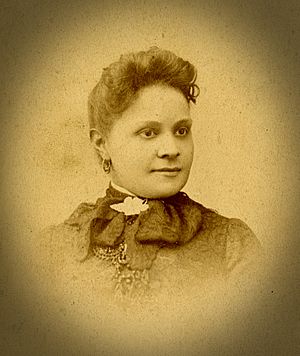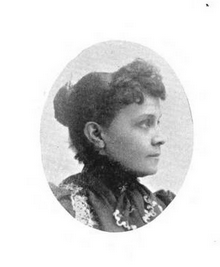Fannie Barrier Williams facts for kids
Quick facts for kids
Fannie Barrier Williams
|
|
|---|---|

Fannie Barrier c. 1880
|
|
| Born |
Frances Barrier
February 12, 1855 Brockport, New York, U.S.
|
| Died | March 4, 1944 (aged 89) Brockport, New York, U.S.
|
| Nationality | American |
| Alma mater | The College at Brockport |
| Occupation | Educator, Activist |
| Spouse(s) |
S. Laing Williams
(m. 1887) |
Fannie Barrier Williams (born February 12, 1855 – died March 4, 1944) was an amazing African American educator and activist. She fought for civil rights and women's rights. Fannie was the first Black woman to join the important Chicago Woman's Club. She was also famous for helping Black people get recognized at the World's Columbian Exposition in 1893. Besides her activism, she was a talented musician, a portrait artist, and she learned several foreign languages.
Contents
Early Life and Family Background
Fannie Barrier Williams was born Frances Barrier on February 12, 1855. She was the youngest of three children. Her parents were Anthony and Harriet Barrier. Her father, Anthony, was born in Pennsylvania. He moved to Brockport, New York as a child. He worked as a barber and later sold coal. Her mother, Harriet, was a housewife. She focused on raising her children and was active in their church.
The Barrier family was one of the few Black families in Brockport. They were quite well-off because her father owned a successful business and real estate. Fannie grew up interacting with white people without facing the harsh discrimination common elsewhere. Her family attended the First Baptist Church. Her father was a respected leader there, and her mother taught Bible classes. Fannie played the piano for the church. They were the only Black family in the church.
In 1904, Fannie wrote about her childhood in Brockport. She said that her family had a very friendly and respectful relationship with the white people in their community.
School Days and Early Challenges
Fannie and her siblings, Ella and George, went to the Brockport Collegiate Institute. This school is now known as SUNY-College at Brockport. Fannie Barrier was the first African American to graduate from this school in 1870.
After graduating, Fannie went south to teach at a school for Black students in Hannibal, Missouri. There, she faced a level of racism she had never seen before. She saw segregation, threats, and physical attacks against Black people. This experience deeply upset her. It made her realize the serious racism faced by women of color. This realization led her to dedicate her life to activism.
Feeling sad about the racism, Fannie left the South. She went to study piano at the New England Conservatory of Music in Boston, Massachusetts. However, white students from the South complained about her being there. She was pressured to leave the school.
After Boston, Fannie moved to Washington, D.C. to teach. She joined a movement focused on educating formerly enslaved people. This community allowed her to connect with other educated Black individuals. But even in Washington, she faced difficulties because of her race. This happened when she tried to study portrait painting at the School of Fine Arts.
While teaching in Washington, D.C., she met Samuel Laing Williams. He was from Georgia and Chicago. They married in Brockport in August 1887. They later moved to Chicago, Illinois. Samuel became a successful lawyer there.
A Life of Social Activism
Fannie Barrier Williams and her husband were important members of Chicago's Black community. They became very active in local reform movements. Chicago's Black elite included both older families and a new generation. This new generation was often born free and educated. Women in this group were more involved in public life than ever before. Working with white organizations was also key to gaining influence.
Fannie was known as an artist and a smart scholar. She was a skilled portrait painter and spoke German. She and her husband helped start the Prudence Crandall Study Club. This group was for Chicago's elite Black Americans. Fannie led the art and music department. She also guided the women's group with her friend and mentor, Mary Jones. They were called the “Cultured Negro Ladies.”
Many white women's groups did not treat Black women as equals. However, Fannie found a place in the Illinois Woman's Alliance (IWA). This group helped connect the Prudence Crandall Study Club with larger public activism. Fannie became Vice President of the IWA in 1889. She worked on a committee focused on the health of poor people.
Fannie worked with famous leaders like Frederick Douglass and Booker T. Washington. She spoke often about why all women, especially Black women, needed the right to vote. Her work for women's rights was recognized when she was the only Black American chosen to speak at Susan B. Anthony's memorial in 1907.
Fannie helped create the National League of Colored Women in 1893. She also helped form its successor, the National Association of Colored Women (NACW) in 1896. She was also a founder of the National Association for the Advancement of Colored People (NAACP). She worked with Mary Church Terrell to create the National Federation of Afro-American Women in 1895.
Fannie played a big part in creating Provident Hospital, which opened in 1891. She strongly pushed for a hospital for Black people, run by Black people. This hospital would also provide much-needed jobs for Black women as nurses.
Fannie used her connections with the IWA to join the white women's club movement. In 1894, she was nominated to be the first Black woman in the Chicago Woman's Club. This was a very important club. When she was nominated, she and her supporters received threats. It was a difficult fight, but she finally became a member in 1896.
Fannie and her husband worked for political clubs like the Hyde Park Colored Voters Republican Club. Fannie was also key in starting the Frederick Douglass Center in 1905. This was a community center she called "the black Hull House." She also helped create the Phyllis Wheatley Home for Girls.
Speaking at the Columbian Exposition of 1893
Fannie Barrier Williams became even more famous for her efforts to get Black people recognized at the Chicago Columbian Exposition in 1893. She succeeded in getting two jobs created for Black Americans. She also made sure that Black American interests were part of the event's program. She was named the Clerk in Charge of Colored Interests for the Exposition.
Fannie was asked to give two important speeches at the Exposition. In her first speech, "The Intellectual Progress of the Colored Women of the United States Since the Emancipation Proclamation," she spoke to the World's Congress of Representative Women. She argued against the idea that slavery had made Black women less smart or moral than other women. She asked all women to unite and fight for their rights. After her speech, Anna J. Cooper and Fanny Jackson Coppin also spoke. Frederick Douglass praised all three women's speeches.
Her second speech was given at the Parliament of the World's Religions. This speech, called "What Can Religion Further Do to Advance the Condition of the American Negro?", asked churches to welcome all people, no matter their race. Fannie believed that religion and faith could help solve society's problems.
Later Life and Lasting Impact
After 1900, Fannie became a strong supporter of Booker T. Washington's ideas of self-improvement. After her husband died in 1921, Fannie stayed in Chicago until 1926. In 1924, she became the first woman and the first Black American to be named to the Chicago Library Board.
She moved back to Brockport in 1926 to live with her sister, Ella D. Barrier. There, she lived a much quieter life. She passed away on March 4, 1944, after a long illness. She was buried in the Brockport Cemetery.
Fannie Barrier Williams left a lasting legacy. In 2014, SUNY-College at Brockport created the Fannie Barrier Williams Women of Courage Scholarship in her honor. This scholarship helps students who show a commitment to social justice. In 2022, the school renamed its Liberal Arts Building after her. The village of Brockport also named October 6, 2022, as Fannie Barrier Williams Day.


